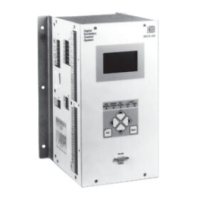DECS-200 BESTCOMS Software 5-17
VAR/PF, var Integral Gain KI.
Adjusts the integral gain, which determines the characteristic of the DECS-
200 dynamic response to a changed var setting. A setting of 0 to 1,000 may be entered in 0.01
increments.
VAR/PF, PF Integral Gain KI.
Adjusts the integral gain, which determines the characteristic of the DECS-
200 dynamic response to a changed power factor setting. A setting of 0 to 1,000 may be entered in 0.1
increments.
VAR/PF, var Loop Gain Kg.
Sets the coarse loop-gain level of the PID algorithm for var control. A setting
of 0 to 1,000 may be entered in 0.01 increments.
VAR/PF, PF Loop Gain Kg.
Sets the coarse loop-gain level of the PID algorithm for power factor control.
A setting of 0 to 1,000 may be entered in 0.1 increments.
SCL, Integral Gain KI.
Adjusts the rate at which the DECS-200 limits stator current. A setting of 0 to 1,000
may be entered in 0.1 increments.
SCL, Loop Gain Kg.
Sets the coarse loop-gain level of the PID algorithm for the stator current limiter. A
setting of 0 to 1,000 may be entered in 0.1 increments.
OEL, Integral Gain KI.
Adjusts the rate at which the DECS-200 responds during an overexcitation
condition. A setting of 0 to 1,000 may be entered in 0.1 increments.
OEL, Loop Gain Kg.
Sets the coarse loop-gain level of the PID algorithm for the overexcitation limiter. A
setting of 0 to 1,000 may be entered in 0.1 increments.
UEL, Integral Gain KI.
Adjusts the rate at which the DECS-200 responds during an underexcitation
condition. A setting of 0 to 1,000 may be entered in 0.1 increments.
UEL, Loop Gain Kg.
Sets the coarse loop-gain level of the PID algorithm for the underexcitation limiter. A
setting of 0 to 1,000 may be entered in 0.1 increments
Voltage Matching, Loop Gain Kg.
Adjusts the coarse loop-gain level of the PID algorithm for matching the
generator voltage to the bus voltage. A setting of 0 to 1,000 may be entered in 0.1 increments.
Analysis
The Analysis screen consists of four tabs labeled AVR, FCR, var, and PF. To view the Analysis screen,
click the Analysis button on the tool bar or click S
creens on the menu bar and click Analysis.
Trigger Data Logging on Step Change.
Checking this box causes an oscillography report to be triggered
every time that a step change occurs.
AVR
AVR tab settings are illustrated in Figure 5-21 and described in the following paragraphs.
Voltage Step Response, Increment of AVR Setpoint.
Sets the voltage step size that the DECS-200 uses
when incrementing the generator terminal voltage setpoint. A setting of 0 to 10% may be entered in 1%
increments. A button adjacent to this setting is clicked to increment the terminal voltage setpoint. A read-
only field indicates the terminal voltage setpoint that will be achieved when the increment button is
clicked. If the specified step size is outside the setpoint limit, a warning message will appear.
Voltage Step Response, AVR Setpoint.
This read-only field indicates the generator terminal voltage set-
point that was set on the AVR/FCR tab of the Setting Adjustments screen. A button adjacent to this field
is clicked to return the AVR setpoint to the displayed value.
Voltage Step Response, Decrement of AVR Setpoint.
Sets the voltage step size that the DECS-200 uses
when decrementing the generator terminal voltage setpoint. A setting of 0 to 10% may be entered in 1%
increments. A button adjacent to this setting is clicked to decrement the terminal voltage setpoint. A read-
only field indicates the terminal voltage setpoint that will be achieved when the decrement button is
clicked.
Voltage Step Response, Vrms.
This read-only field indicates the value of terminal voltage. The other three
fields are described in the corresponding tab setting descriptions.
Alarm Signals.
During step response analysis, nine alarm indicators are available to indicate system
alarms. The indicators annunciate the following conditions:
• Field overcurrent
• Field overvoltage
• Generator overvoltage
• Generator undervoltage

